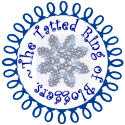Remember, I told you with Sparks yoke, you have to look at the pictures to see where to make the joins? The problem is, some of the pictures aren't very good. If the picture isn't clear, look around, and you may find a better picture on another page. Anyway, I didn't do that one time and realized later I had a motif joined in the wrong place.
We've all had mistakes and had to cut away. It's a little more complicated when the cut away part includes a picot that was joined to by some later tatting that you don't want to cut out.
Here is how I handle that situation.
Disclaimer: some of the scans were made from the front side to show tatting you would be working from the backside. Instead of making more scans, I flipped the pictures around, so don't pay too much attention to whether the stitches in the pictures look like front or back.
Fixing mistakes in tatting that was joined to later:
Carefully clip away the offending piece, leaving bits attached. If you are certain which bits formed joins instead of picots, go ahead and pull only those off. If in doubt, pull out just the core thread of all the bits.
If the bit was forming a join, then both threads will come away from the picot it was joined to.
When the bit was forming the picot, it will remain attached to the remaining tatting when the core thread is pulled out. Don't pull out the picot thread just yet.
Look carefully at the two thread ends sticking out one side of the tatting and find where the connecting thread lies on the other side. Use a needle to pull it up partway.
Now that you know where to re-create the joined picot, put this part away and make the new replacement tatting until you get to this point. Unwind the ball thread shuttle or cut off a long length of the ball thread and put it in your smallest sewing needle. Put on your best pair of reading glasses.
Arrange the old tatting in your hand in position to join to it. Pull on the loop so that just the one thread end nearest you is pulled out. Immediately...
... put the ball thread needle through the tiny hole while you can still see it. Try to put it through in the same direction that the thread end just came out.
Now pull the rest of the bit of thread out and put the ball thread needle through the other hole. Check carefully to make sure the ball thread is in the right direction to form a picot. I will admit I got mine backward the first time, which would have formed a twisted picot. I pulled the ball thread back out and used a couple more fine needles to mark the holes while I put the ball thread back in the needle and tried again.
Once your are sure everything is right, adjust the ball thread to the length of a picot and resume tatting.
While making all those close ups on the scanner, the background was nice too.


















































Thank you, amazing.
ReplyDeleteThank you for your very clear and detailed explanation!
ReplyDeleteThis is very useful, thanks. I've sometimes given up on a repair job because the picot was a joining one. Turns out there is a solution!
ReplyDeleteGreat tip, Martha. Loved the suggestion of putting on glasses first! I'm lucky as I have to wear mine all the time!
ReplyDeleteI have done this too, these old patterns are gorgeous I am glad some pictures are left for us, it's better than nothing at all💮 and glad you are documenting your work I do believe this helps others Thank you 🌻🌻🌻🌻🌻
ReplyDeleteI'd not figured out how to fix this type of error. I guess you're right, the only way is with a free end and a needle. Thank you so much! I can't wait to see you at Tat Days. -Linda R
ReplyDeleteLooks like you are making awesome progress on your yoke!! :)
ReplyDeleteThanks for posting this method. This is a fantastic way to fix the 'had to cut off the picot everything joins to' problem.
ReplyDeleteStephanieW
Fabulous work, Ms M! And that yoke is looking splendid - hope to see it in Toccoa!
ReplyDeleteExcellent !!! Thanks for sharing :-)
ReplyDeleteI once did a repair with a bit of difference, but you need longer ends for it. I threaded each end in a needle and 'sewed' it through the new motif to resemble a picot, whip stitching both ends in opposite directions to the new motif.
I think I like your method better .